Yamahiraen Discuss the Essence of Hand-Rolled Tea and Tea to Enrich the Soul【Fuji Tea, Shizuoka Prefecture】
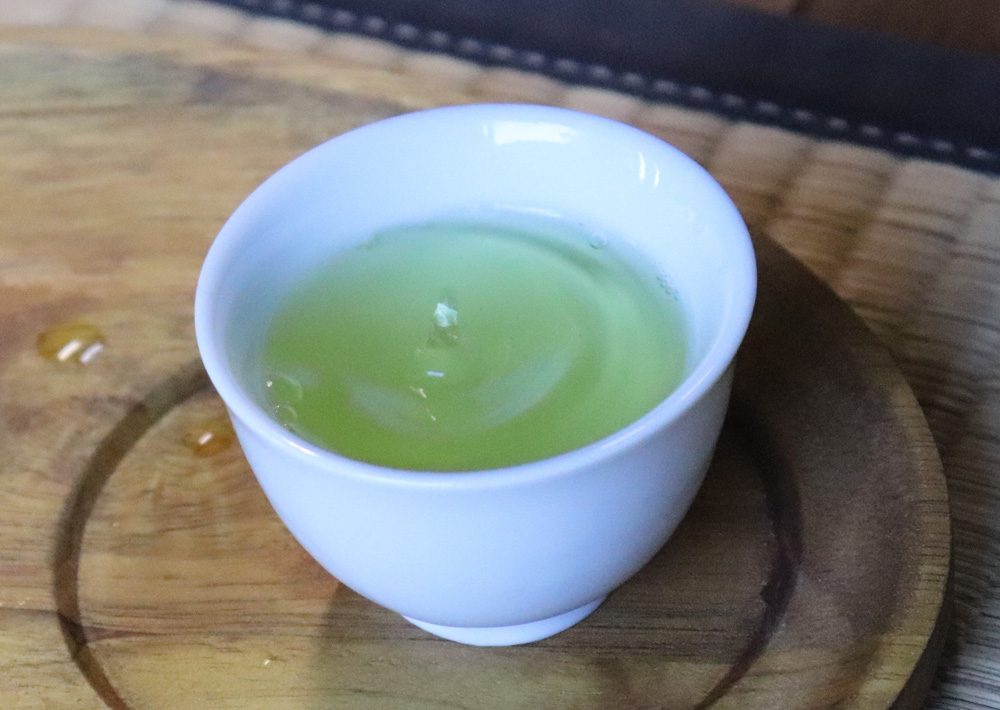
On the Suzu River valley, southeast of Mt. Fuji, Mr. Toshihiro Hirayanagi, the fourth-generation owner of Yamahiraen, has been passionately involved in tea farming for more than 30 years and has also devoted himself to the preservation of the “hand-rolling” technique. His commitment to preserving and passing on these long-cultivated hand-rolling techniques has led to his appointment as chairman of the Shizuoka Prefecture Hand-Rolled Tea Preservation Association in March 2019, and also as chairman of the National Hand-Rolled Tea Promotion Association in March 2021.
In this article, we will discuss the art of hand-rolled tea and his hope to offer consumers a delightful experience through tea crafted with care, in an interview with Toshihiro Hirayanagi, the fourth-generation owner of Yamahiraen, and his wife, Keiko Hirayanagi.
Contents
- 1 About Yamahiraen
- 2 Introduction to Yamahiraen’s Tea
- 3 Interview: The Essence of Hand-Rolled Tea and Tea to Enrich the Soul
- 3.1 Toshihiro Hirayanagi, chairman of the National Hand-Rolled Tea Promotion Association, answers the question, “What is hand-rolled tea?”
- 3.2 An invitation to the world of hand-rolled tea: from an experience anyone can enjoy, to a rare skill
- 3.3 The decline in production of Shizuoka tea and the problems behind it threaten its future.
- 3.4 Yamahiraen want to focus on producing high-quality products, but the circumstances prevent me from doing so.
- 3.5 Yamahiraen recommends a moment of tea time to revitalize the soul
- 4 Information of Yamahiraen
About Yamahiraen
Yamahiraen is a tea farm located along the Suzu River valley, a clear stream in the Ashitaka mountain range, southeast of Mt. Fuji that handles everything from organic farming to tea production and sales. The current owner is Toshihiro Hirayanagi, the fourth generation of the family.
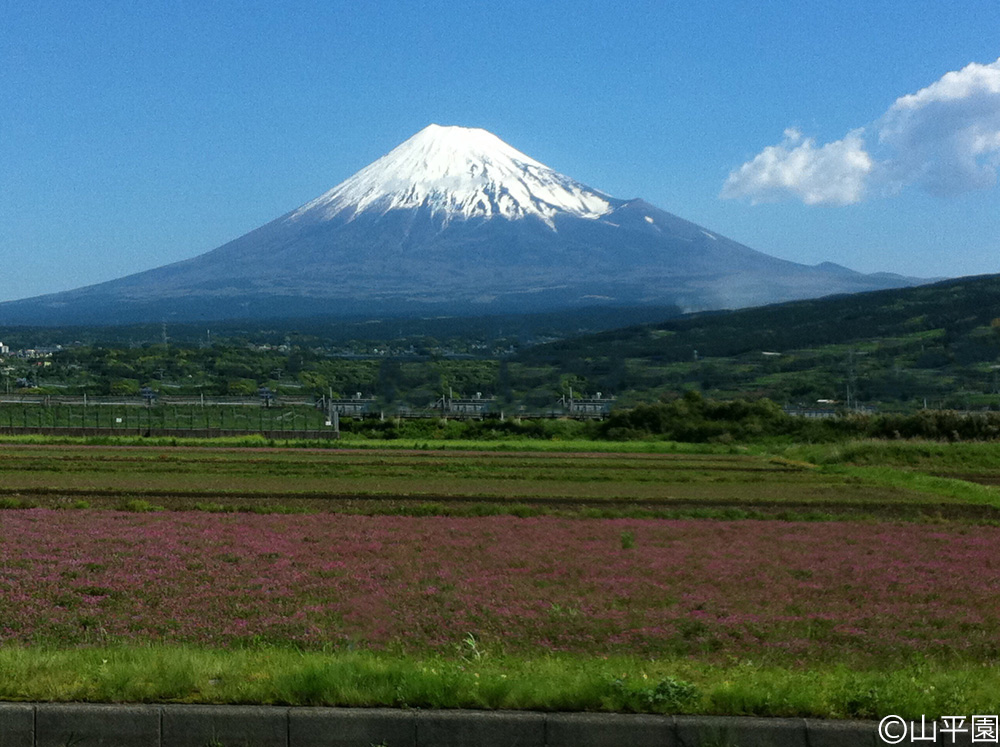
In 1990, Mr. Hirayanagi quit his job at his company and chose to become a farmer. In 1991, at the age of 36, he became the new owner of Yamahiraen and built a tea factory adjacent to his home. At the same time, he opened a tea store.
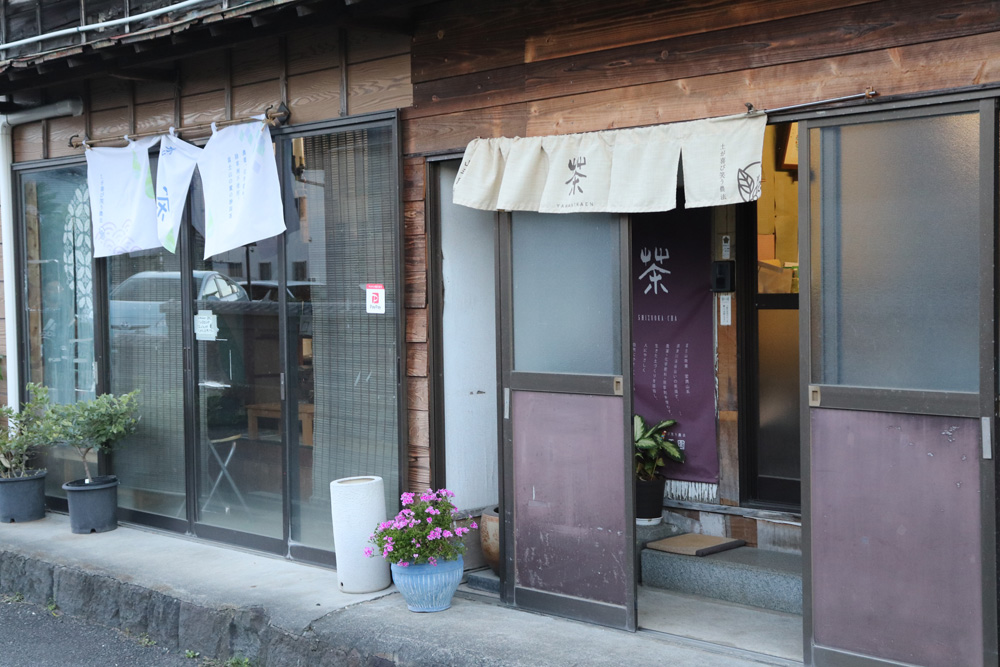
Toshihiro Hirayanagi, the fourth-generation owner of Yamahiraen, serves as the chairman of the National Association for the Promotion of Hand-Rolled Tea.
Although tea is now commonly produced with machines, in the past, tea masters used a technique called “hand-rolling” to create tea using their hands.
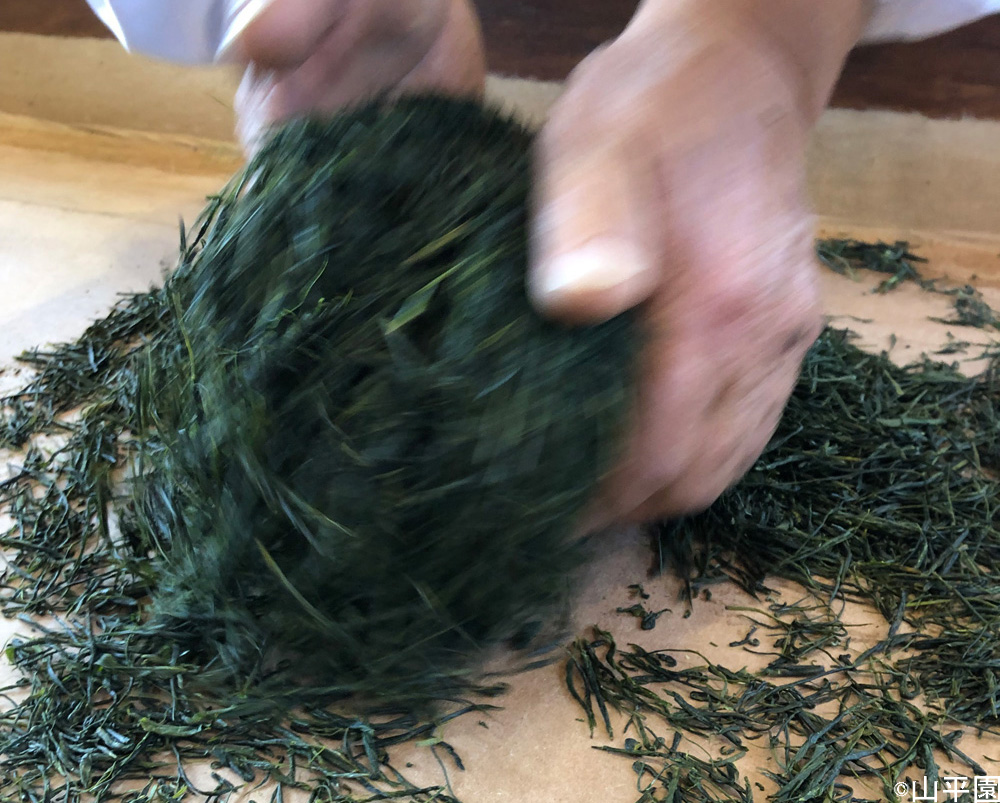
In 1991, Mr. Hirayanagi joined the Fuji City Hand-Rolling Preservation Society to learn the fundamentals of tea making and to participate in a region with a thriving tea industry. Since then, he has worked tirelessly to preserve and pass on the technique of “hand-rolling” tea. As a result of his accomplishments, he has been serving as the chairman of the Shizuoka Prefecture Tea Hand-Rolling Preservation Association since March 2019.
Furthermore, from March 2021, he will also serve as Chairman of the National Association for the Promotion of Hand-Rolled Tea.
Introduction to Yamahiraen’s Tea
Yamahiraen has been cultivating tea using organic methods since 2003, without the use of pesticides or chemical fertilizers. The company offers a variety of rare teas, including tea made by natural tea cultivation, hand-picked, and hand-rolled teas. These products are available for purchase. (For an explanation of natural tea cultivation, see the article on Morinouchi Tea Farm).

They also focus on producing single-origin teas, which means a tea from a particular region and farmer without blending different varieties. The most popular tea variety is “Yabukita,” but Mr. Hirayanagi suggests that the cultivation of the Harumidori variety is better suited for the conditions at Yamahiraen.
Here, we would like to introduce a few of Yamahiraen’s teas.
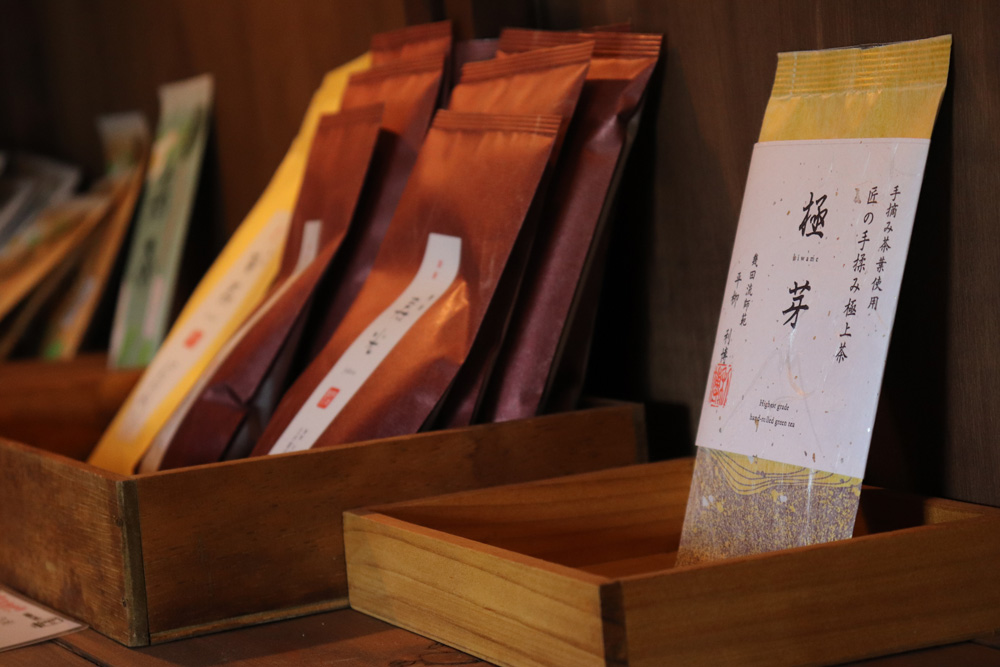
Hand-picked green tea “Shin” Harumidori
The new sprouts of “Harumidori,” a tea variety known for its full-bodied taste , are hand-picked one by one and carefully processed to bring out their unique characteristics in natural tea cultivation. The result is a rich flavor and a stunning aroma that can make your daily routine feel more luxurious.
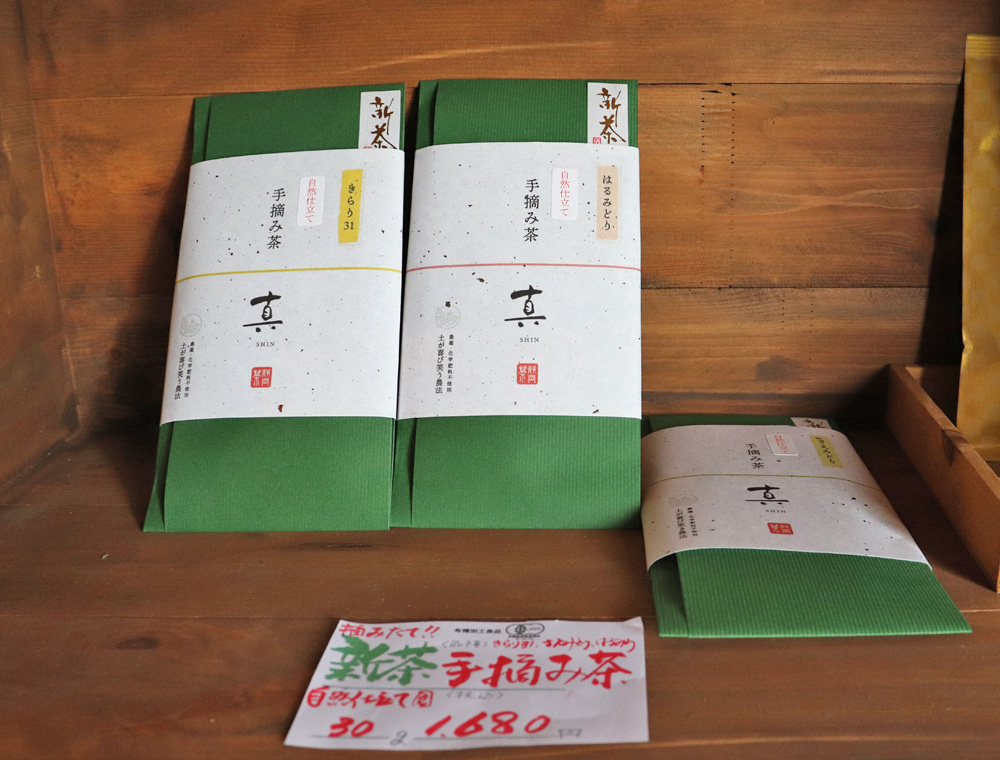
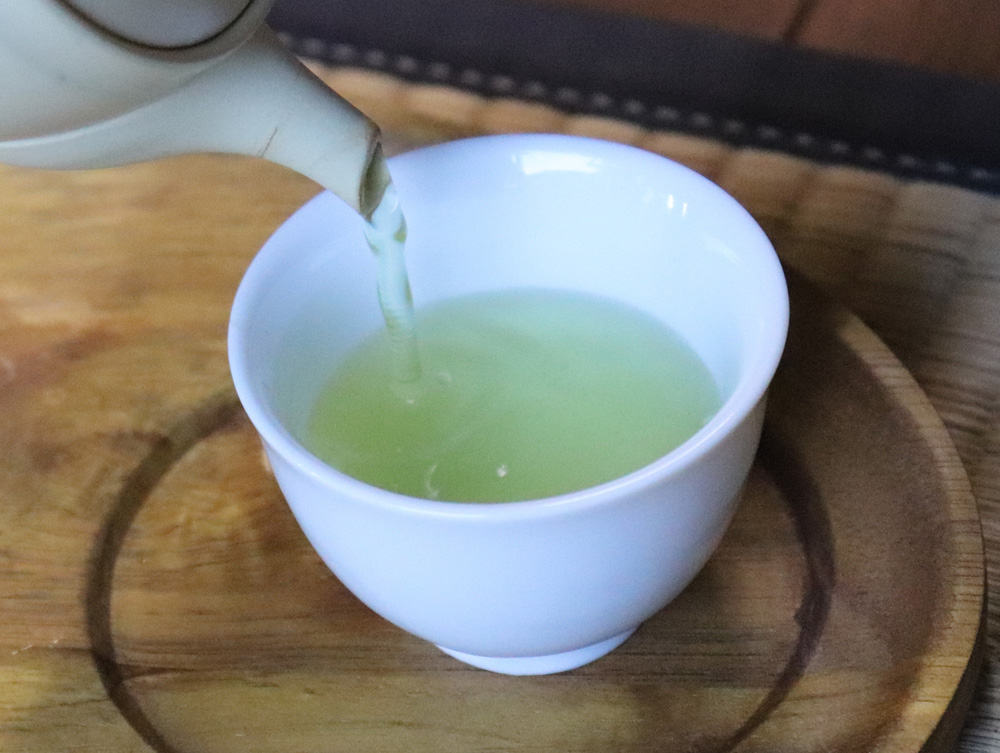
“Shin” Harumidori is highly recommended by Mr. Hirayanagi, the owner of the farm. Consider it as a gift for tea lovers.
Satoyama Black Tea, Genmaicha (Brown rice tea), and Hojicha (Roasted tea)
Satoyama black tea has a gentle, sweet taste with no peculiarities. It is recommended to be enjoyed without any additives. Hojicha is made from high-quality tea leaves, luxuriously roasted to give a soothing aroma and a subtle sweetness. It is caffeine-free, making it ideal for children. Genmaicha, also known as brown rice tea, has fragrant roasted brown rice that blends perfectly with Yamahiraen’s tea leaves, giving it a bright green water color. These teas are also available in tea bags.

Yamahiraen teas can be purchased either online or directly at the factory. They are also available at the following locations: Shin-Tomei Suruga Bay Numazu Upward SA Neopasa, “Ocha no Koujyuan” at Izumura station in Mishima, Fujikawa Rakuza, “Uchi no Kome Umai Yo” in Mitaka, Tokyo, and at the Fujinokuni Tea Museum, Shizuoka.
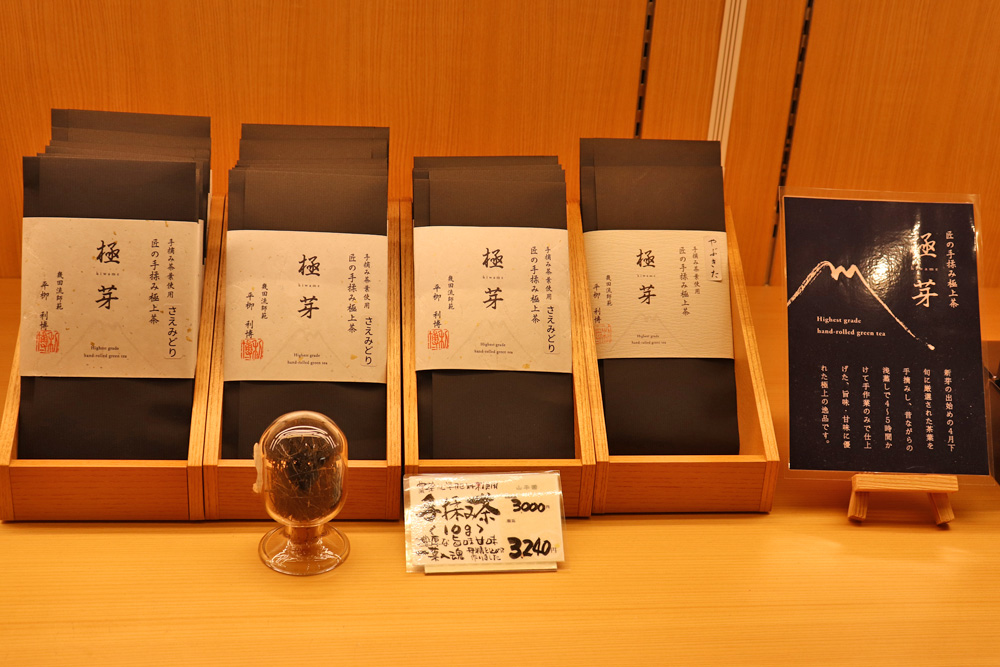 ▲Yamahiraen tea sold at the Fujinokuni Tea Museum, Shizuoka.
▲Yamahiraen tea sold at the Fujinokuni Tea Museum, Shizuoka.
Interview: The Essence of Hand-Rolled Tea and Tea to Enrich the Soul
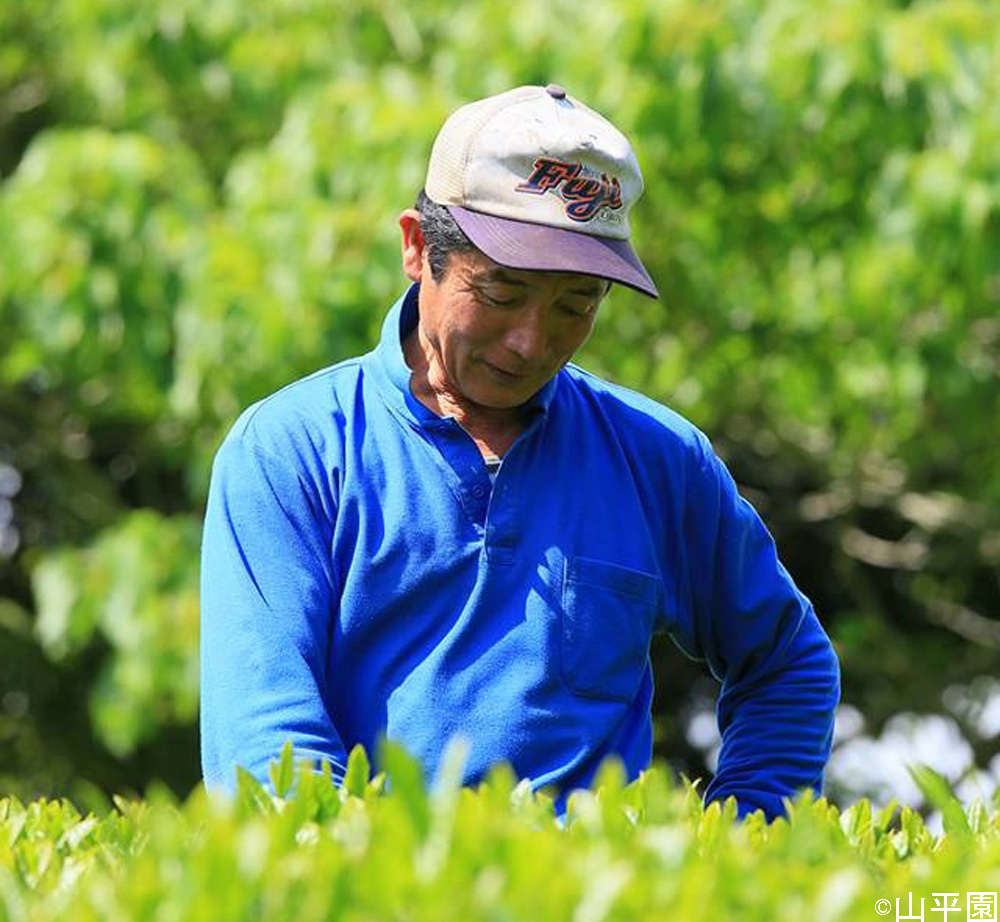
We interviewed Toshihiro Hirayanagi, owner of Yamahiraen, and his wife Keiko Hirayanagi.
Toshihiro Hirayanagi, chairman of the National Hand-Rolled Tea Promotion Association, answers the question, “What is hand-rolled tea?”
–Please tell us about hand-rolled tea.
Hand-rolled tea is made by rolling tea leaves by hand. Typically, a machine is used to finish the tea-making process. While using a machine can speed up the production of tea, it can also harm the delicate fibers of the leaves. In fact, the greenish color of brewed sencha is due to tea powder that leaks out from the leaves.
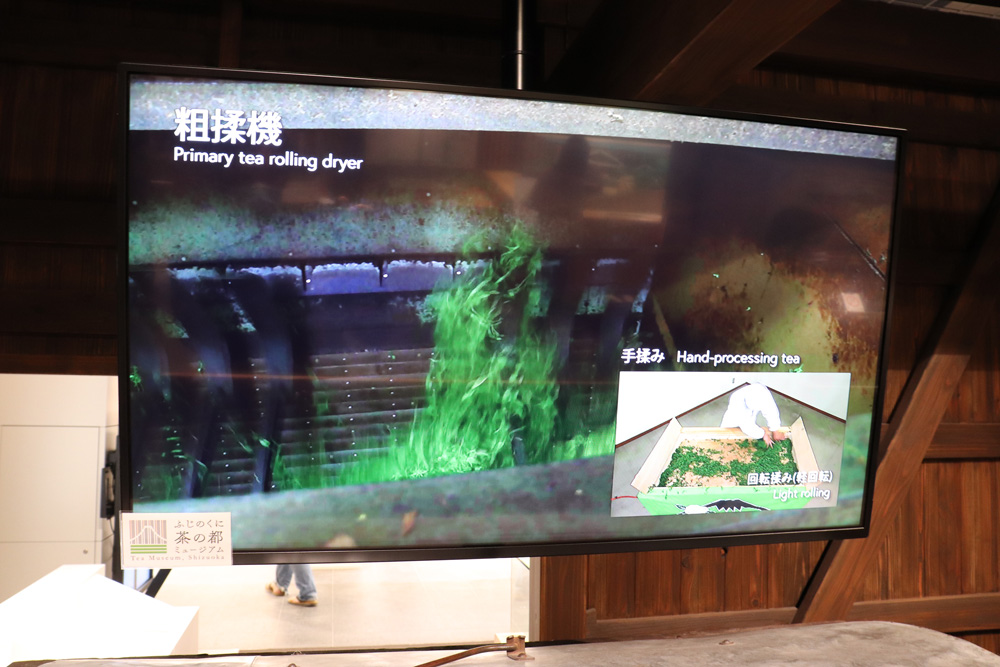
Rolling a large amount of tea leaves using a machine produces a greater quantity of tea, however, this method damages the fibers of the leaves and causes the pigment to leak out, resulting in a darker and less transparent tea. Hand-rolling limits the producer to only the amount of leaves that will fit in his hand, producing a smaller quantity of tea, however, it is gentler on the tea leaves and prevents damage to their fibers. As a result, the tea powder, which is the source of the pigment, does not leak out and the resulting tea is nearly colorless and transparent when brewed.
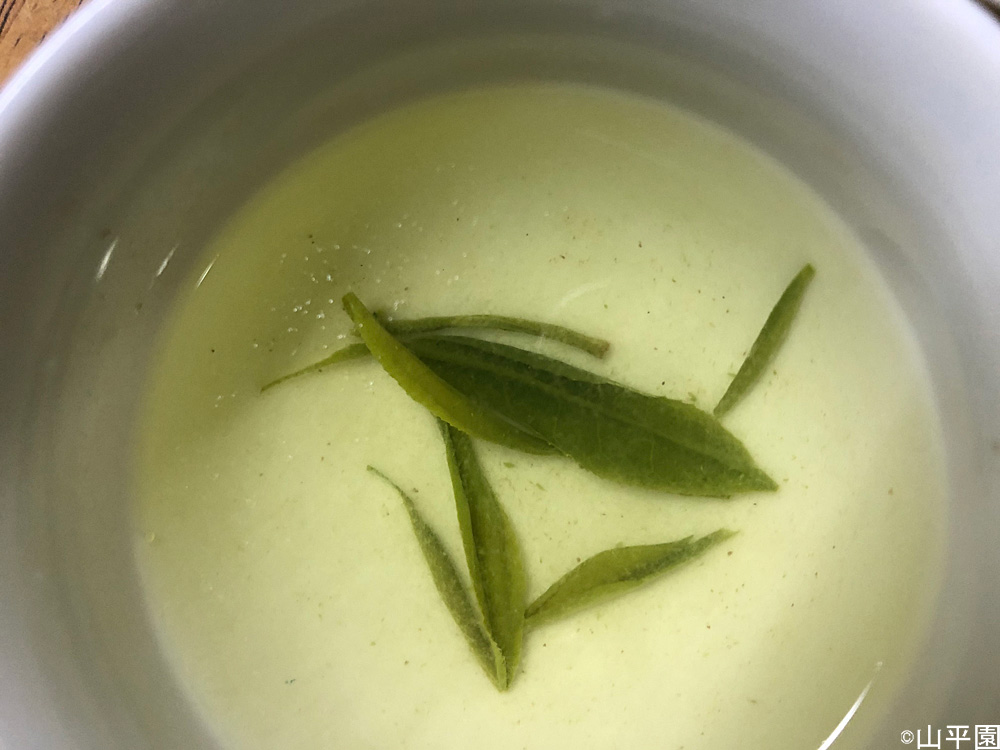 ▲Compared to deep steamed tea, the water color of hand-rolled tea looks lighter green. Tea masters of the past would say “Roll the tea leaves as if you’re talking to them.”
▲Compared to deep steamed tea, the water color of hand-rolled tea looks lighter green. Tea masters of the past would say “Roll the tea leaves as if you’re talking to them.”
In the past, tea masters would roll the leaves by hand to finish the tea. The tea-making machine is designed to replicate the hand-rolling technique of the tea masters.
Tea-making machines are commonly used to roll tea, resulting in almost all teas on the market being machine-rolled. It is extremely rare to have the opportunity to drink hand-rolled tea.
–Where can I get hand-rolled tea?
If it is my hand-rolled tea, you can buy it at our retail store or online store. You can also find my hand-rolled tea at the sales store in the Fujinokuni Tea Museum, Shizuoka.
–The label on the package says “Ikuta-ryu” on it. Are there other methods of hand-rolling tea?
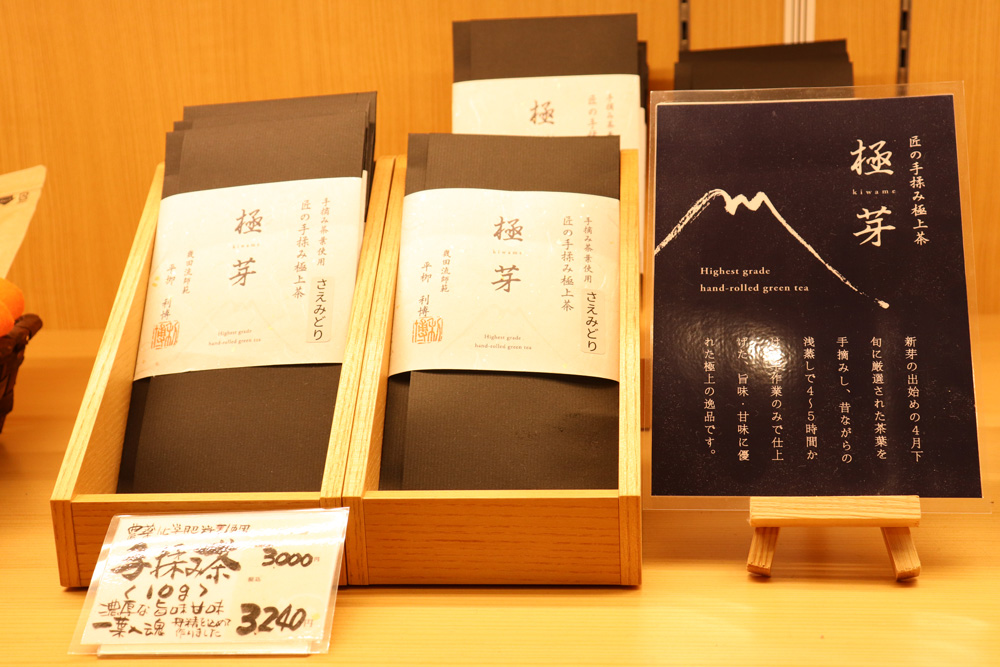
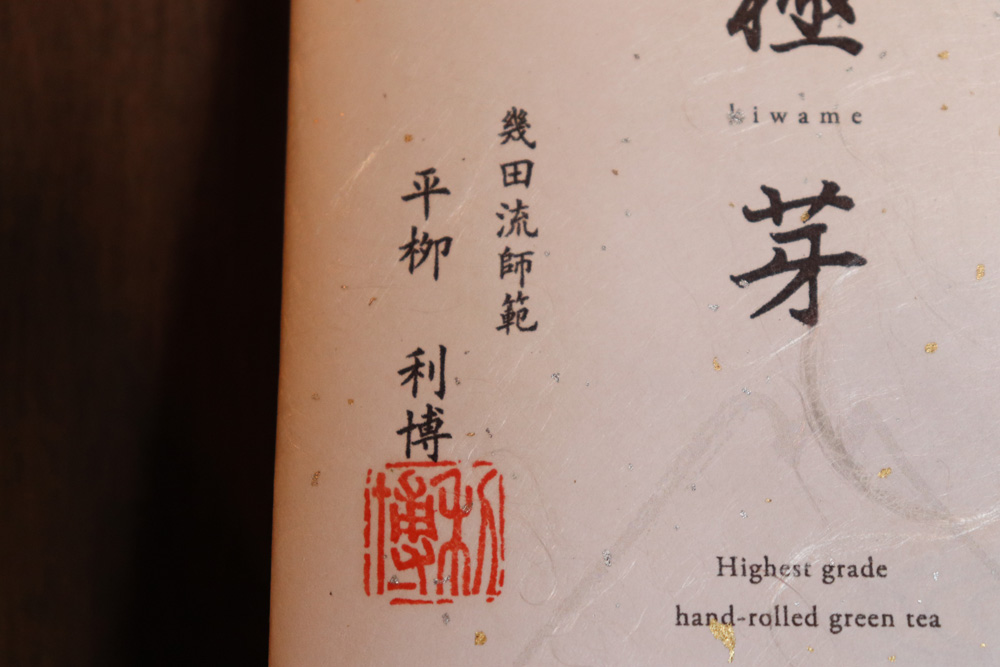
There are many different hand-rolling methods, and currently, there are eight different styles of hand-rolling in Shizuoka Prefecture.
Seito-ryu (Seito style)
Ogasa-ryu
Ikuta-ryu
Soukai-ryu
Kawakami-ryu
Houmei-ryu
Okitsu-ryu
Kawane-momikiri ryu
There are currently 18 chapters in Shizuoka Prefecture, each of which has its own organization called the Hand-Rolled Tea Preservation Society, which aims to pass on the art of hand-rolling to future generations. I am the chairman of the Shizuoka Prefecture Hand-Rolled Tea Preservation Association and the chairman of the National Hand-Rolled Tea Association.
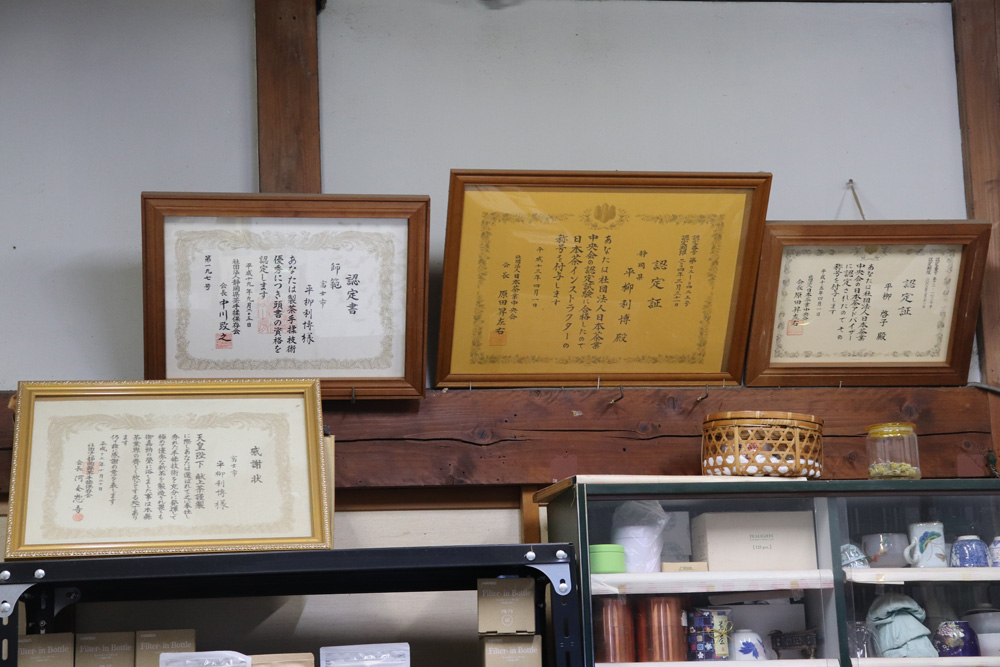
An invitation to the world of hand-rolled tea: from an experience anyone can enjoy, to a rare skill
–It appears to be quite challenging.
There is a simple method that anyone can follow to make delicious hand-rolled tea. Firstly, pick some tea leaves from a tea bush and roll them by hand on a hot plate. Repeat the process of rolling and drying for about 30 minutes, and your hand-rolled tea will be ready to enjoy.
Once you become familiar with the process, you can experiment with making more delicious hand-rolled tea on your own. Additionally, you may want to attend a workshop to learn more. The Fujinokuni Tea Museum, Shizuoka in Makinohara offers hand-rolled tea workshops all year round.
They are held on the second and fourth Sundays of every month. There are four instructors. The average number of participants per workshop is 20. The price is 300 yen for 20 minutes.
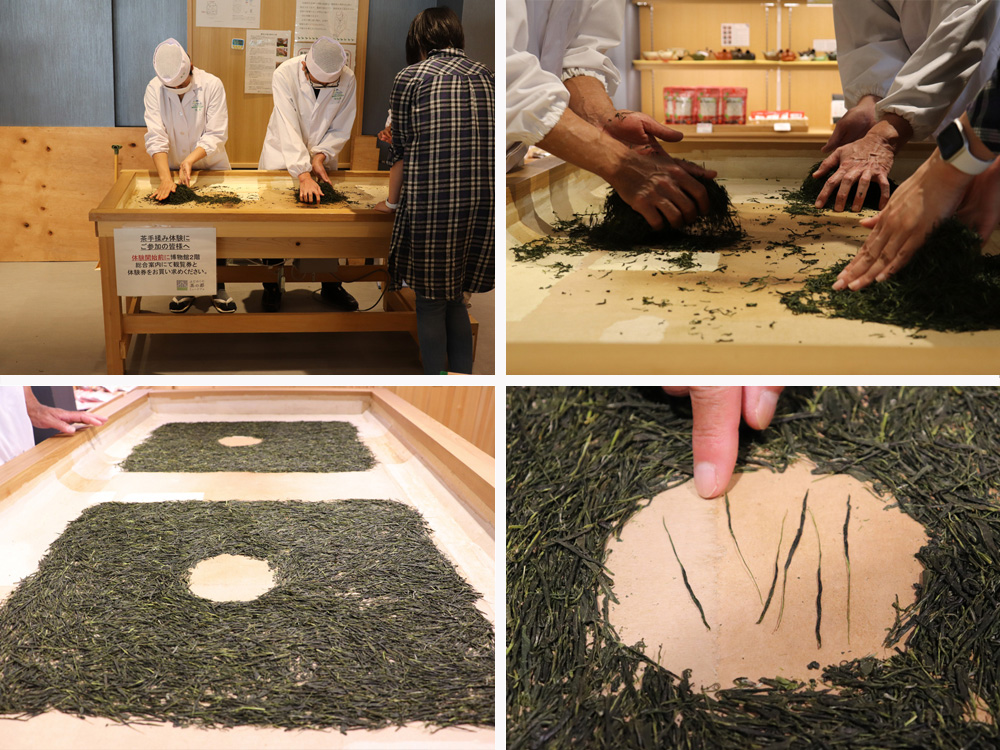 ▲Hand-rolled tea workshop at the Fujinokuni Tea Museum, Shizuoka.
▲Hand-rolled tea workshop at the Fujinokuni Tea Museum, Shizuoka.
These hand-rolled tea workshops where tea producers and consumers can interact and learn from each other are fascinating. By keeping the required materials for hand-rolling tea in the freezer, the workshops can be held all year round, regardless of the season.
If there are any requests, we can also hold advanced workshops where you can pursue the tea that suits your taste buds best! The taste of tea varies from year to year, so you will never get bored of it (laughs).
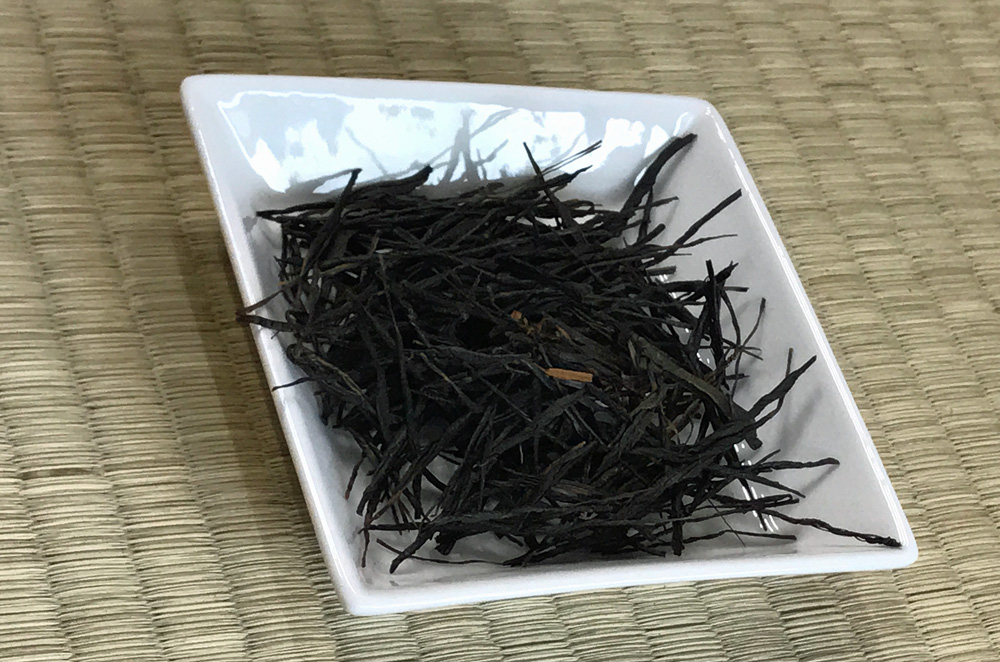 ▲Hand-rolled black tea. Hand-rolling is a tea processing technique that can be applied to a variety of teas, not just green tea(sencha).
▲Hand-rolled black tea. Hand-rolling is a tea processing technique that can be applied to a variety of teas, not just green tea(sencha).
I want to improve my hand-rolling technique so that I can make the best hand-rolled tea in Japan. I am willing to put in all the effort required to achieve this goal. Additionally, gyokuro tea can also be made by hand-rolling, it is sold at 5,000 yen for 10 grams.
–5000 yen for 10g! That’s very expensive! Who are the people who buy it?
Mainly wealthy Chinese people (laughs).
The decline in production of Shizuoka tea and the problems behind it threaten its future.
(Keiko Hirayanagi, Toshihiro Hirayanagi’s wife, joined us for the interview.)
(Toshihiro Hirayanagi) The media often compares the production volume of Shizuoka with that of Kagoshima, but it’s important to closely examine the data. Just because Shizuoka tea production is reported to be decreasing, it doesn’t necessarily mean that Kagoshima tea production is increasing at a rapid rate.
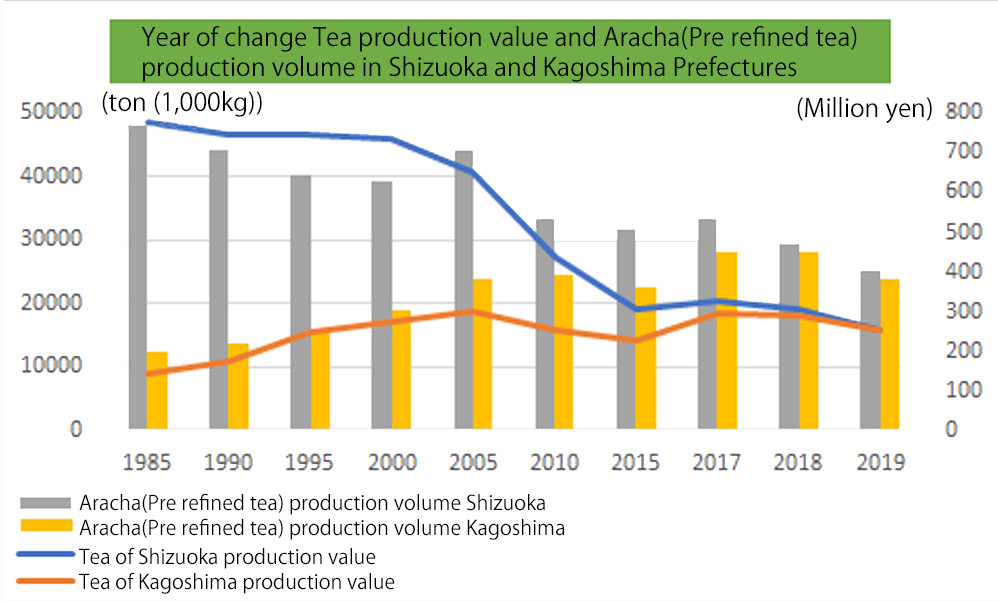
(Keiko Hirayanagi) The production volume of Shizuoka tea is not the only thing that is declining. Its name recognition is also decreasing. During my visits to tea events and festivals in Tokyo, I noticed that tea enthusiasts are giving more attention to the Fukuoka Yame tea(Yame-no-cha) and Kagoshima varieties of tea. In fact, many did not mention Shizuoka, despite it being the number one tea-producing area in Japan.
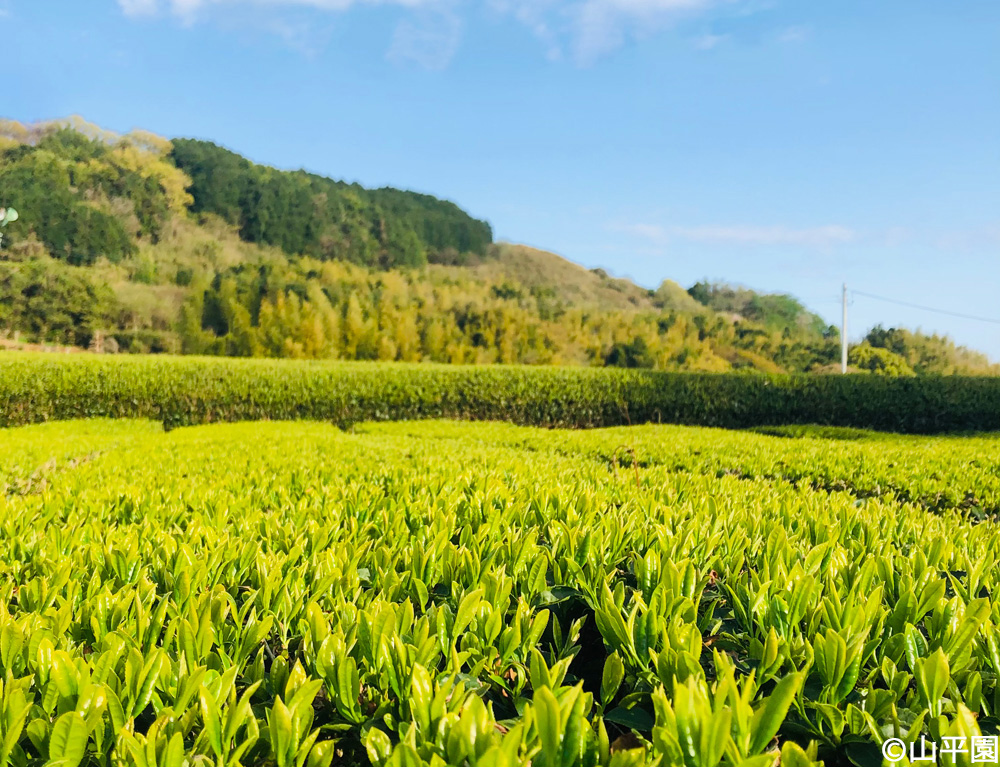
–What do you think is the reason for the drop in production?
(Toshihiro Hirayanagi) Due to the low price of tea, producers are not making any profit, resulting in a decline in production.
–Why do you think the price of tea is low?
I believe that there are various factors contributing to the decline in tea prices, but the use of ride-on machines for tea picking is one of the main reasons. (Specifically, the introduction of passenger-type machines that move through the tea fields as if a person were driving a car has contributed significantly to the decline.)
Before the invention of riding machines, tea leaves were harvested manually. Only a few dozen kilograms of tea leaves could be harvested in a day. However, with the development of riding machines, it is now possible to harvest tens of thousands of kilograms of tea leaves per day with ease.
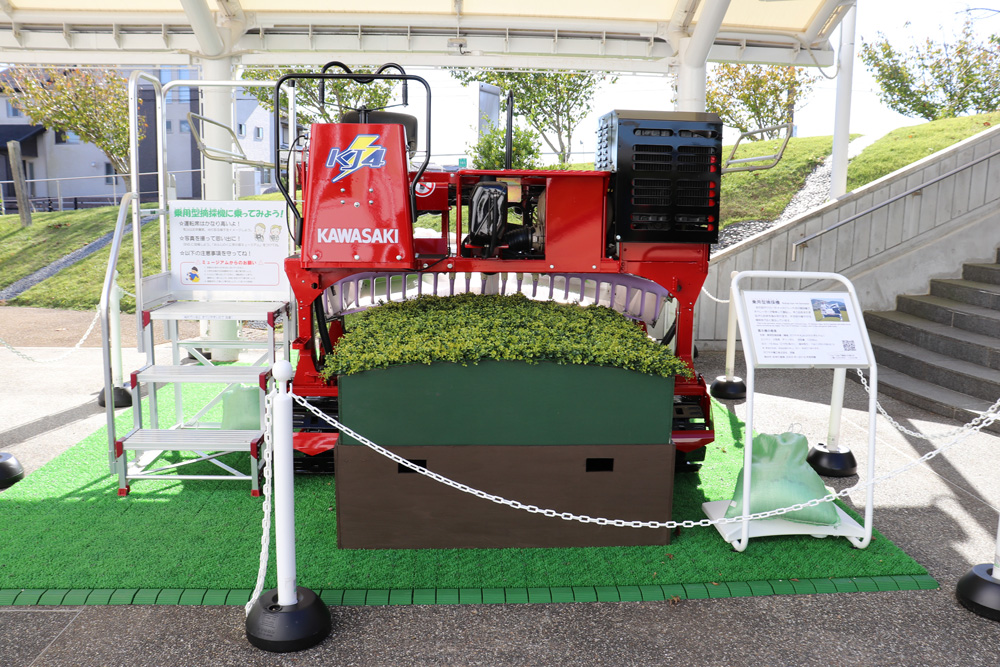 ▲A ride-on tea picker machine on display at the Fujinokuni Tea Museum.▼ A person picking by hand.
▲A ride-on tea picker machine on display at the Fujinokuni Tea Museum.▼ A person picking by hand.
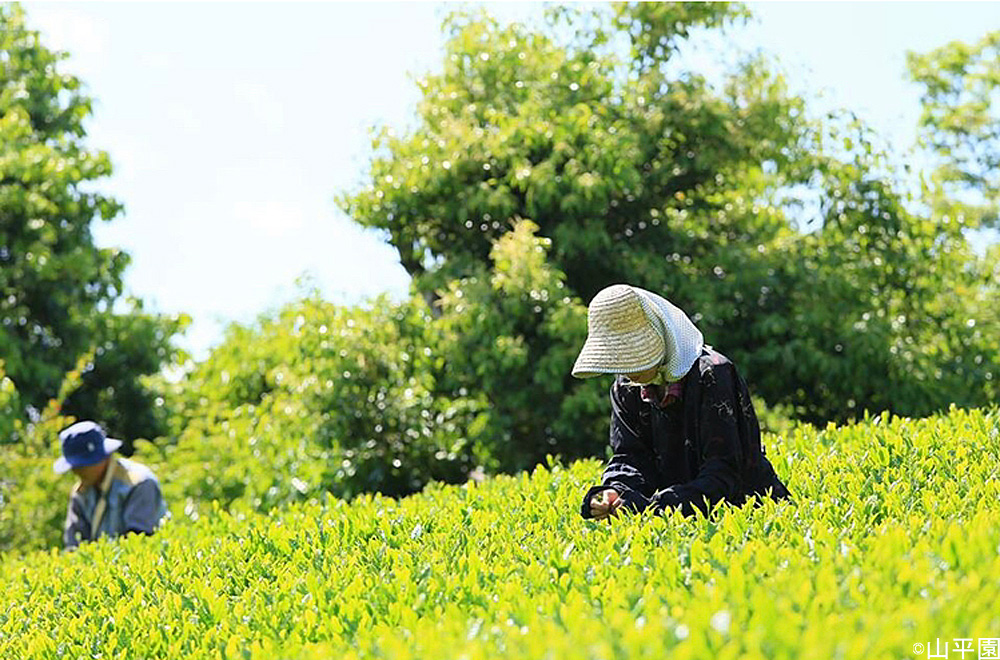
In the past, the cost of aracha(aracha, the material for tea, tea wholesaler purchased from tea farmers) was roughly 500 yen per kilogram. If 10,000 kilograms of tea were harvested in a day using a ride-on machine, earnings of over 5 million yen would be generated every day. However, that would not be sustained forever. It is only natural for the price of tea to decrease over time.
(Aracha refers to the state of tea just before it is turned into a finished tea product. Typically, tea farmers sell aracha wholesale to tea wholesalers who specialize in finishing tea. Aracha is, therefore, a raw material for tea wholesalers. For a detailed explanation of the journey that tea takes from tea farmers to tea wholesalers, please refer to the article by Yamanashi Shoten.)
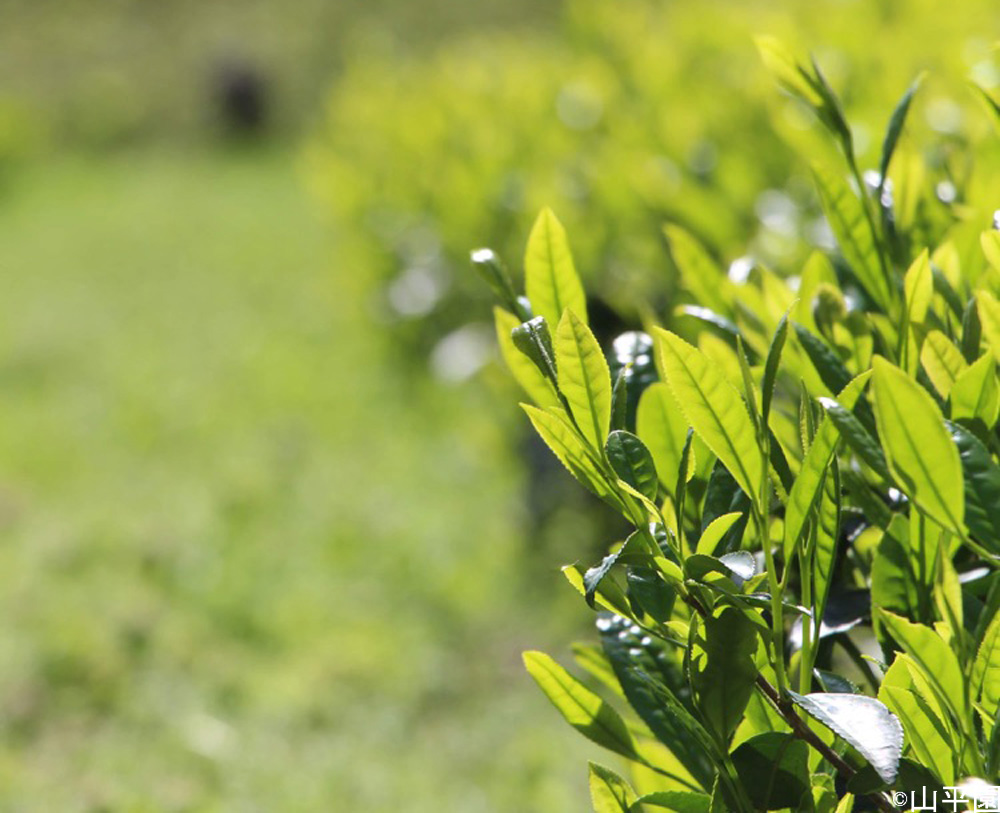
–The decline in the price of tea is attributed to the increase in supply due to mass production. However, the data suggests that the decrease in Shizuoka tea production is unusual. What could be the reason for this anomaly?
(Toshihiro Hirayanagi) I believe that the issue lies in the fact that tea grown on flat land is considered equal to tea grown on slopes, such as in the mountains. This, in my opinion, is a peculiar situation.
Tea fields in the Kyushu region, like Kagoshima, have more flat land and less slopes. This makes it easier for large machines to enter, allowing for large quantities of tea to be harvested in a short period of time. The tea fields in this area are also larger than those in Shizuoka. As a result, the cost of mass production and mass harvesting can be kept down, making the tea business viable even if the price of tea is low.
Tea fields in the mountains of Shizuoka are a common sight. The slopes are so steep that it becomes quite challenging for large machinery to enter. As a result, the tea leaves must be picked by hand.
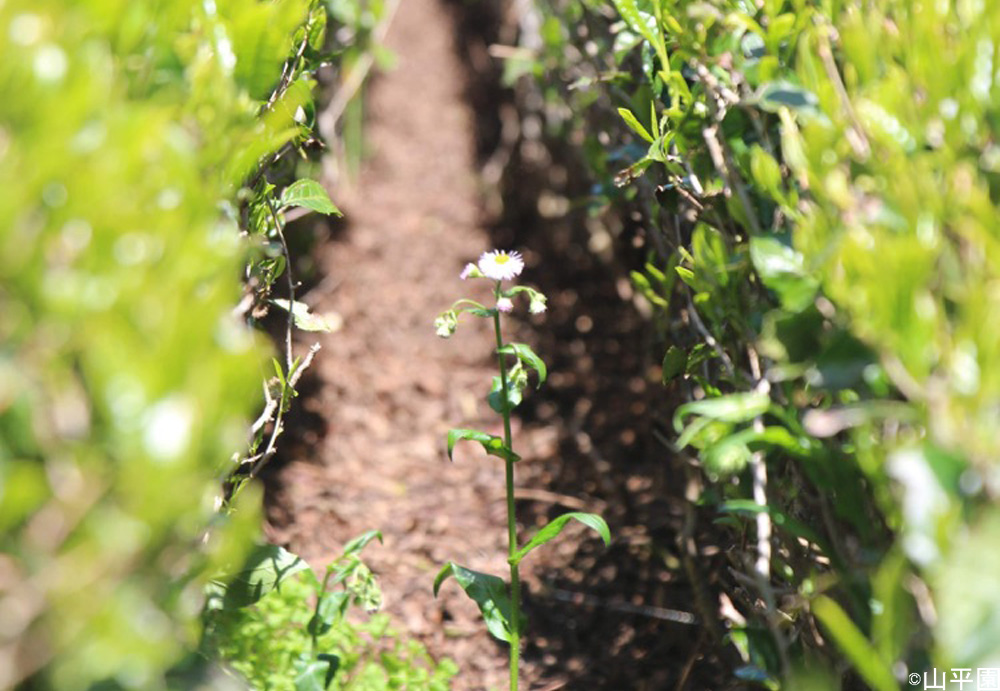
While hand-picking is a time-consuming process, it ensures a better quality of tea. However, the yield is far less in comparison to a ride-on tea picker machine. An advantage of using human workers to harvest crops is that they can sort the parts as they pick them. On the other hand, when using machines, large amounts of crops are harvested at once, which leads to a high yield but also makes it likely that various parts of tea will get mixed in.
Naturally, there will be differences in the taste of the tea. I am not attempting to pass judgment on whether one tea is better or worse than the other. However, it is evident that the two teas are not the same. Despite this, the price of the teas is not significantly different. As a result, tea farmers in the mountains are quitting one after another because they cannot expect to make a profit.
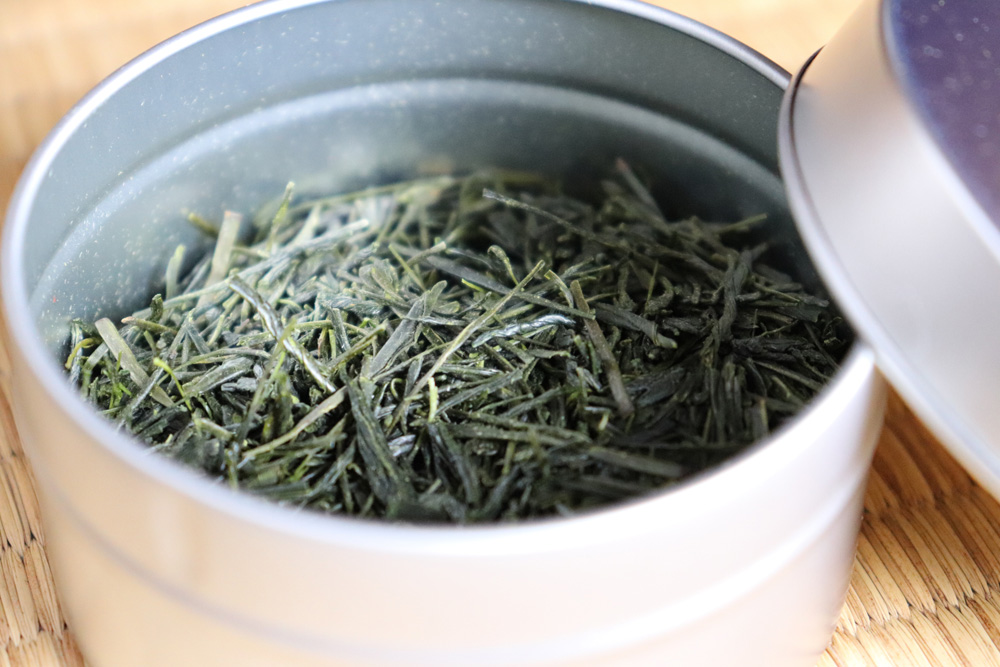
Yamahiraen want to focus on producing high-quality products, but the circumstances prevent me from doing so.
(Toshihiro Hirayanagi) Yamahiraen started cultivating organic tea in 2003 and has been following a farming method that aims to “make the soil smile” by avoiding the use of pesticides and relying solely on nature-friendly fertilizers like fish meal, soybean meal, and reeds.
Yamahiraen aims to farm in a sustainable way that is in harmony with rivers, insects, and plants, and that can be passed down to the next generation. However, since they do not use herbicides, weeding during the summer season is a very difficult and arduous task.
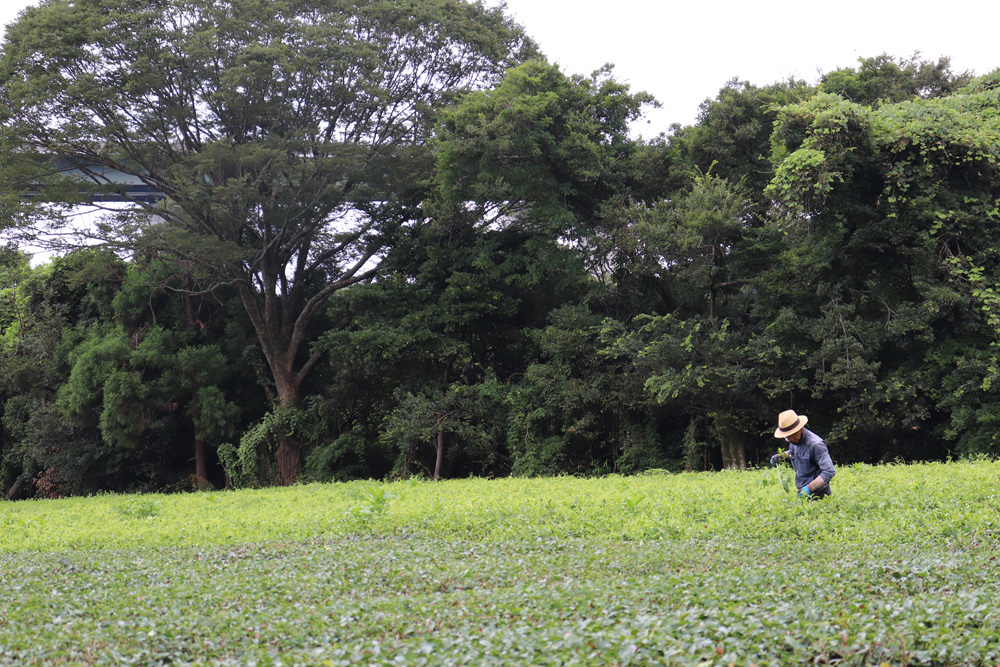 ▲Manual weeding under the scorching sun. Truly grueling work.
▲Manual weeding under the scorching sun. Truly grueling work.
(Keiko Hirayanagi)We also pursue organic certification, but it can be very expensive to obtain. The cost can run into thousands of dollars. Moreover, the application process requires an enormous amount of documentation, which can be a significant burden for farmers. It can be challenging to manage this kind of work while simultaneously focusing on farming.
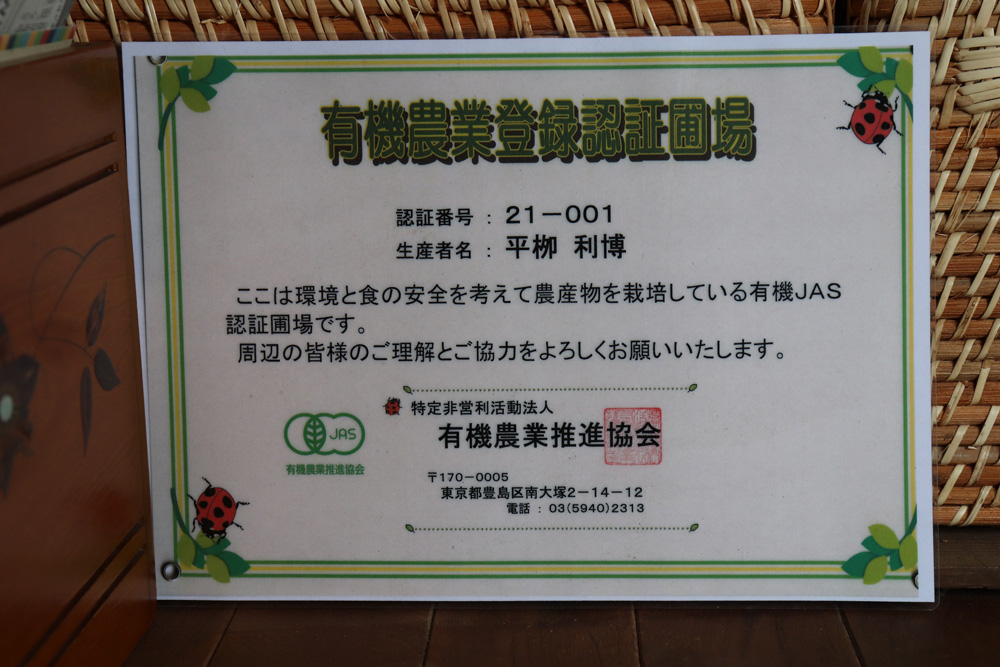 ▲Yamadairaen obtained JAS organic certification in 2021.
▲Yamadairaen obtained JAS organic certification in 2021.
In the article discussing Aitoen, Mr. Aito made a statement that resonated with me. He said, “I want to focus on producing high-quality products, but the circumstances prevent me from doing so.” As tea farmers, we share his sentiment. Nowadays, we have reached a stage where we can no longer sustain ourselves without marketing our own products.
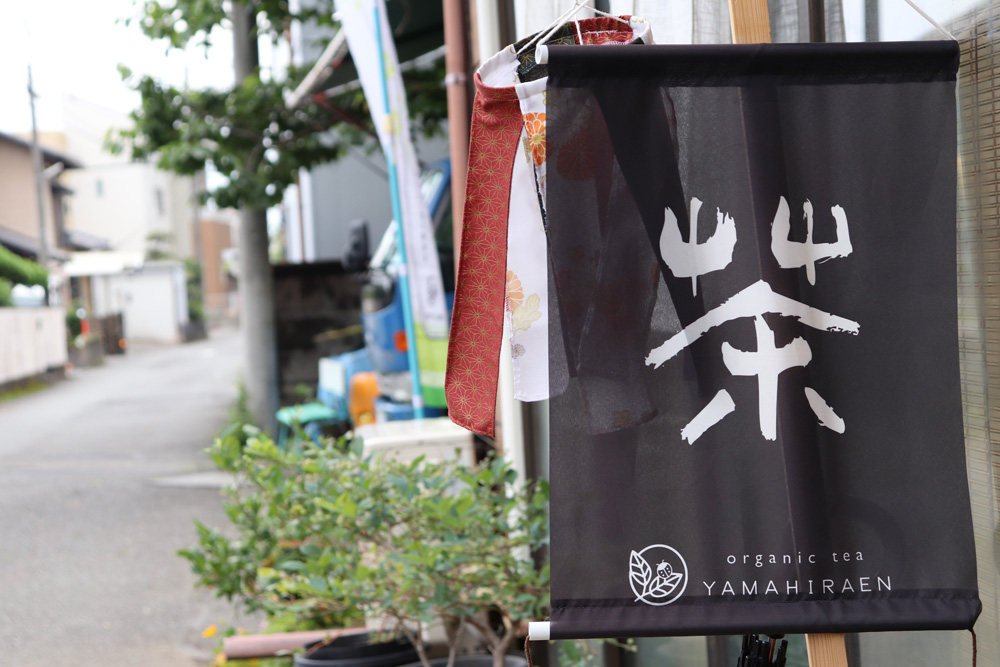
(Toshihiro Hirayanagi) Even in the Shizuoka tea industry, there are calls for automation. However, if automation becomes a reality, large corporations will surely enter the market. The difference in capital between us and the big companies is massive, so there is no way we can compete with them in the same field.
We have no other way to survive but to engage in farming products that require a lot of work, which the large corporations cannot enter.
–So you are called to take on the challenge of skills that are difficult to automate.
If Japan, which has no natural resources, can compete in the world, it will be through skills. The Japanese may be small in stature, but they are rich in wisdom. I believe that the Japanese are people who survive through their skills.
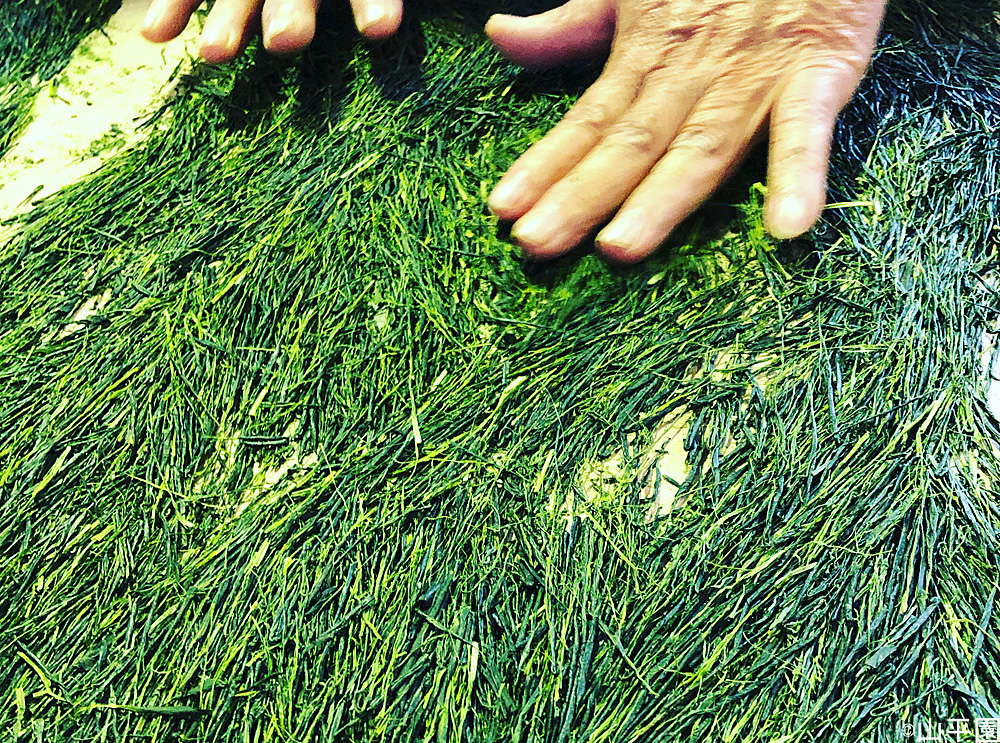
I believe that teahouses can also find a way to succeed if they make full use of their unique skills. I would like to insist on hand-picking, but the burden of labor costs is heavy when requesting hand-picking. Above all, the people who can pick by hand are getting older, and the number of people able to do it is decreasing daily.
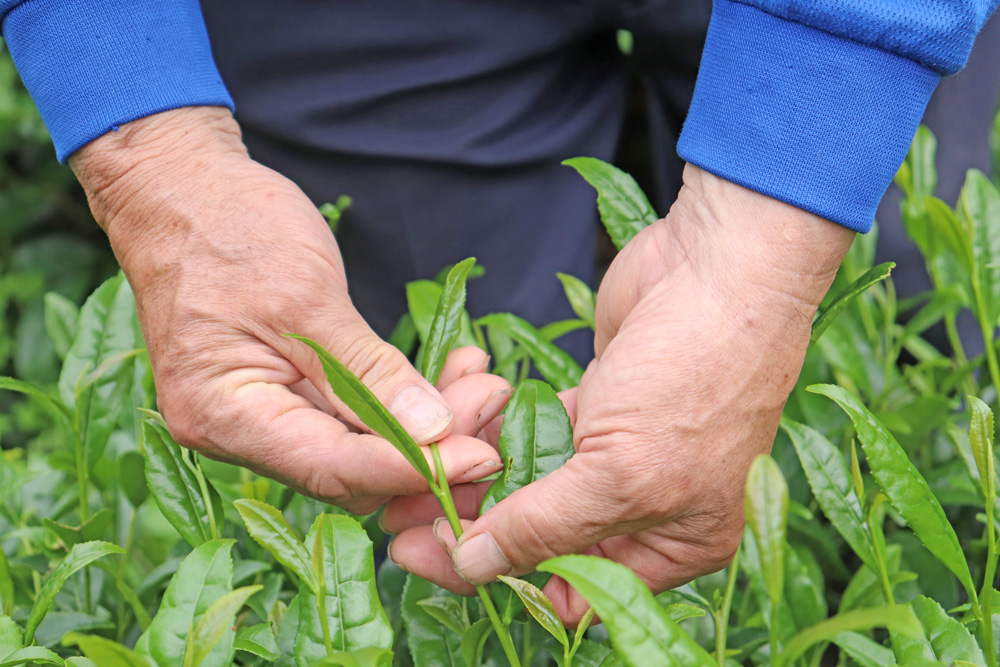
Yamahiraen recommends a moment of tea time to revitalize the soul
–Please tell us about Yamahiraen’s goal in tea production.
(Toshihiro Hirayanagi) I think our goal is not to make a tea that moistens the throat but to make a tea that “moistens the heart”, with a higher emphasis on quality.
–“Moisten the heart” is a very beautiful expression.
From time to time, we are interviewed by people from other countries, but it is difficult to translate because they don’t have the concept of “moistening the heart” in other countries (laughs). I believe that if we keep a good cup of tea by our side to moisten our hearts while we work, it will help our dealings proceed smoothly.
(Keiko Hirayanagi) It has long been said that people don’t fight when they are drinking tea. Tea has great power.
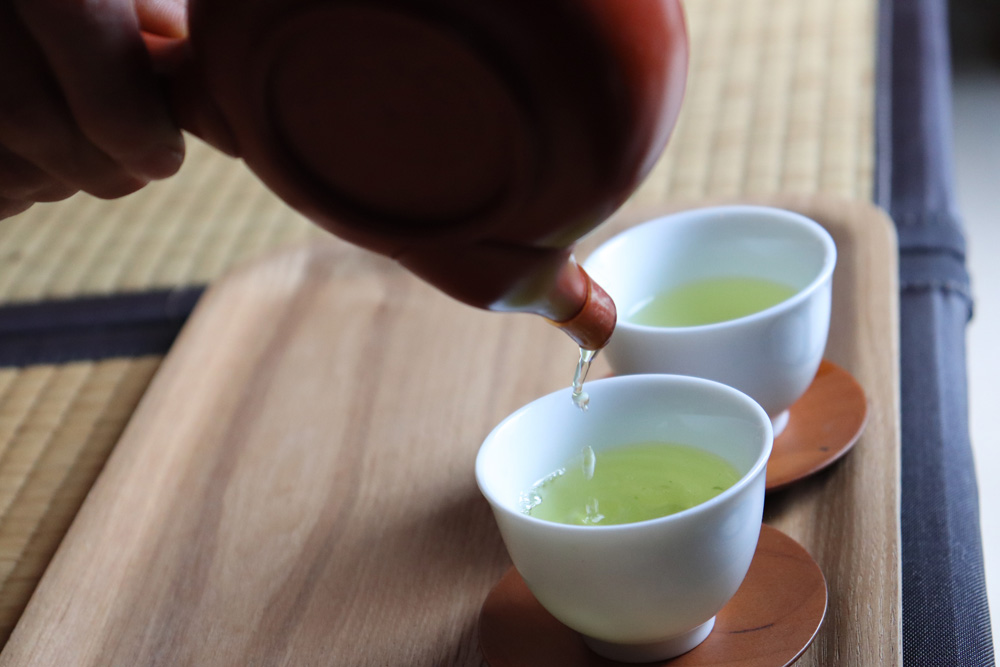
I hope that more people will take time out from their daily routine to enjoy a relaxing cup of tea from Yamahiraen, which will moisten their throats and hearts. Our social insurance consultant friend is a tea-lover who serves tea to his workmates during lunch breaks. He is working to increase the number of tea fans while enjoying himself (laughs).
–I see. Perhaps your own tea made at the handmade tea workshop could be the tea that revitalizes your soul.
Tea made by your own hands and unique to you has a very special flavor. It would also be a great souvenir, and I would like to hold such workshops in the future.

Related articles : Fuji Marumo Tea Garden Entrusts a Joyful Style of Tea to the Future【Fujion tea, Shizuoka Prefecture】
Information of Yamahiraen
| Address | 1021 Nakazato, Fuji City, Shizuoka Prefecture, 417-0826 Japan |
| Website | http://yamahiraen.net/ |
| Phone number | +81 545-34-1349 |
| E-money and credit cards | Available |
| Open | 10am-5pm. |
| Closed | Contact Yamahiraen |
| Parking lot | A few parking spaces are available |
| Access | 15 minutes by car from the nearest station, Shin-Fuji Station 15 minutes by car from Yoshiwara Station. |
| Writer | Norikazu Iwamoto |
| Career | Ochatimes chief editer. Meeting with Vice Governor of Shizuoka prefecture. Judge of Shizuoka 100 tea’s award in 2021~23. Ocha Times link introduced at website of World O-CHA(Tea) Festival 2022, Tea Science Center, The City of Green Tea Shizuoka, Ministry of Agriculture, Forestry and Fisheries. |
| English translator | Calfo Joshua |
| Career | Born and raised in England, living in Japan since 2016. Studying arboriculture in Shizuoka Prefecture whilst operating his landscape business Calfo Forestry. Appreciating the nature of Japan and the culture that places such importance in it. |


 Go to Japanese page
Go to Japanese page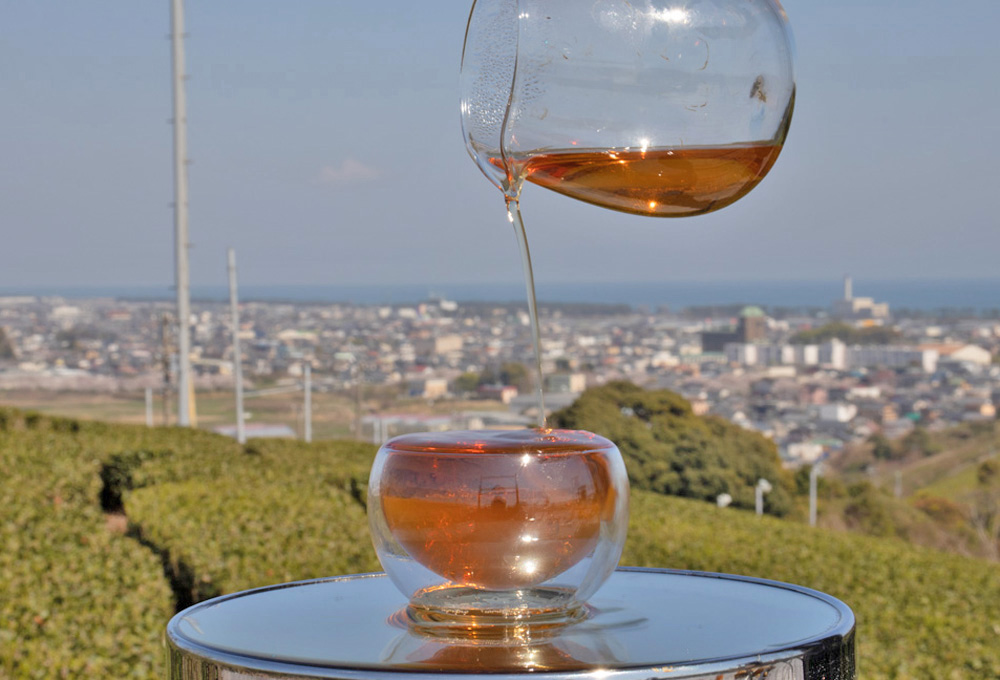
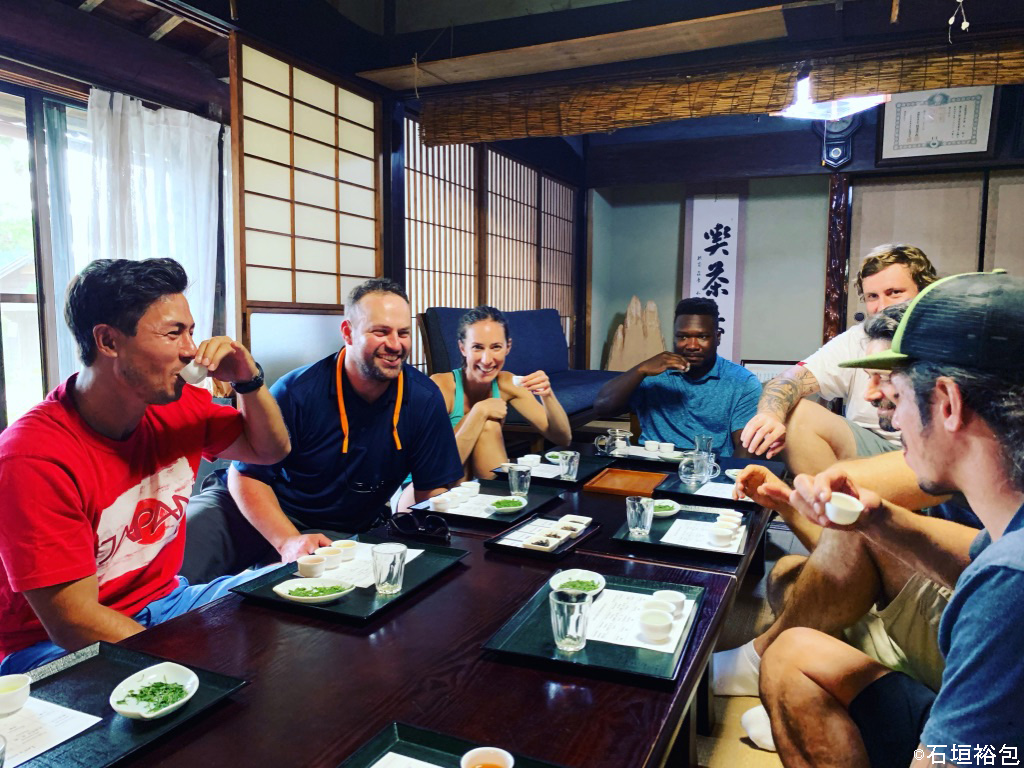
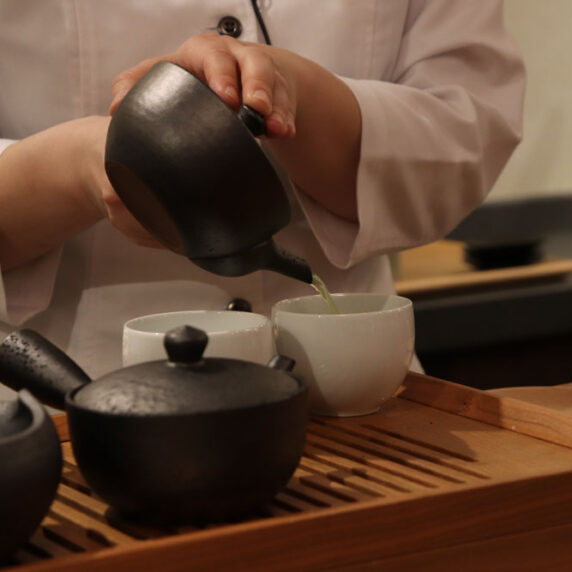
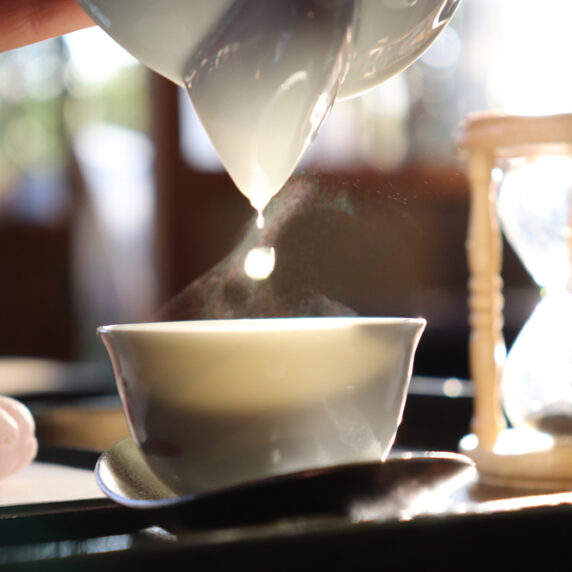
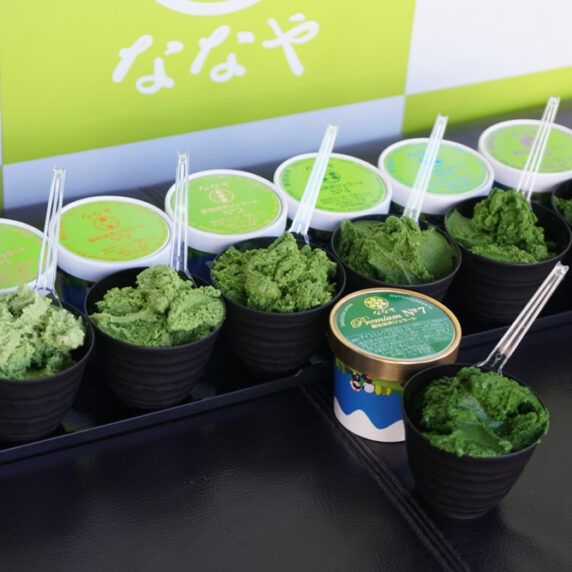
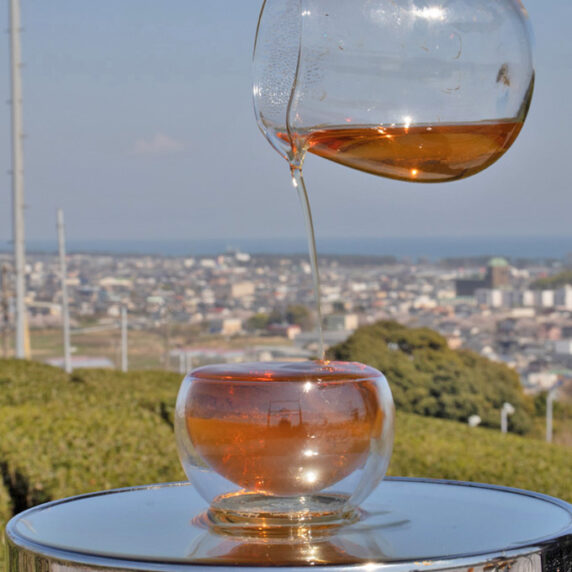





 on the red bar to close the slide.
on the red bar to close the slide. to see the distance between the current location to the Chaya.
to see the distance between the current location to the Chaya.